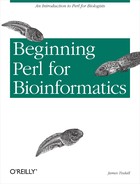In biological research, the search for sequence similarity is very important. For instance, a researcher who has isolated a potentially important DNA or protein sequence wants to know if it's already been identified and characterized by another researcher. If it hasn't, the researcher wants to know if it resembles any known sequence from any organism. This information can provide vital clues as to the role of the sequence in the organism under study. And when no such resemblance is found, it is evidence that the sequence may belong to a new class of genes or gene products.
The Basic Local Alignment Search Tool (BLAST) is one of the most popular software tools in biological research. It tests a query sequence against a library of known sequences in order to find similarity. BLAST is actually a collection of programs with versions for query-to-database pairs such as nucleotide-nucleotide, protein-nucleotide, protein-protein, nucleotide-protein, and more.
This chapter examines the output from the nucleotide-nucleotide version of the program, BLASTN . For simplicity's sake, I'll simply refer to it here as BLAST. The main goal of this chapter is to show how to write code to parse a BLAST output file using regular expressions. The code is simple and basic, but it does the job. Once you understand the basics, you can build more features into your parser or obtain one of the fancier BLAST output parsers that's available via the Web. In either case, you'll know enough about output parsers to use or extend them.
This chapter also gives you a brief introduction to Bioperl, which is a collection of Perl bioinformatics modules. The Bioperl project is an example of an open source project that you, the Perl bioinformatics programmer, can put to good use. The Perl programming language is itself an open source project. The program and its source code are available for use and modification with only very reasonable restrictions and at no cost.
There are several implementations of BLAST. The most popular is probably the one offered free of charge by the National Center for Biotechnology Information (NCBI): http://www.ncbi.nlm.nih.gov/BLAST/. The NCBI web site features a publicly available BLAST server, a comprehensive set of databases, and a well-organized collection of documents and tutorials, in addition to the BLAST software available for downloading.
Also popular is the WU-BLAST implementation from Washington University. The main web site, including a list of other WU-BLAST servers, can be found at http://blast.wustl.edu. Older versions of WU-BLAST are available at no charge. Newer versions are free if you qualify as a research or nonprofit organization and agree to the licensing arrangements from Washington University where the program is developed and maintained. If you work at a major research organization, you may already have a site license for the WU-BLAST program. If you are a for-profit company, there is a rather hefty charge for the newer WU-BLAST program (older versions are freely available if you want to run BLAST on your own computer). Pennsylvania State University also develops some BLAST programs, available at http://bio.cse.psu.edu/. In addition to NCBI and WU-BLAST, many other BLAST server web sites are available. A Google search (http://www.google.com) on "BLAST server" will bring up many hits.
A big question that faces researchers when they use BLAST is whether to use a public BLAST server or to run it locally. There are significant advantages to using a public server, the largest being that the databases (such as GenBank) used by the BLAST server are always up to date. To keep your own up-to-date copy of these databases requires a significant amount of hard-disk space, a computer with a fairly high-end processor and a lot of memory (to run the BLAST engine), a high-capacity network link, and a lot of time setting up and overseeing the software that updates the databases. On the other hand, perhaps you have your own library of sequences that you want to use in BLAST searches, you do frequent or large searches, or you have other reasons to run your own in-house BLAST engine. If that's the case, it makes sense to invest in the hardware and run it locally.
The online documentation for BLAST is fairly extensive and includes details on the statistical methods the program uses to calculate similarity. In the next section, I touch briefly on some of those points, but you should refer to the BLAST home page and to the excellent material at the NCBI web site for the whole story and detailed references. Our interest here is not the theory, but rather to parse the output of the program.
